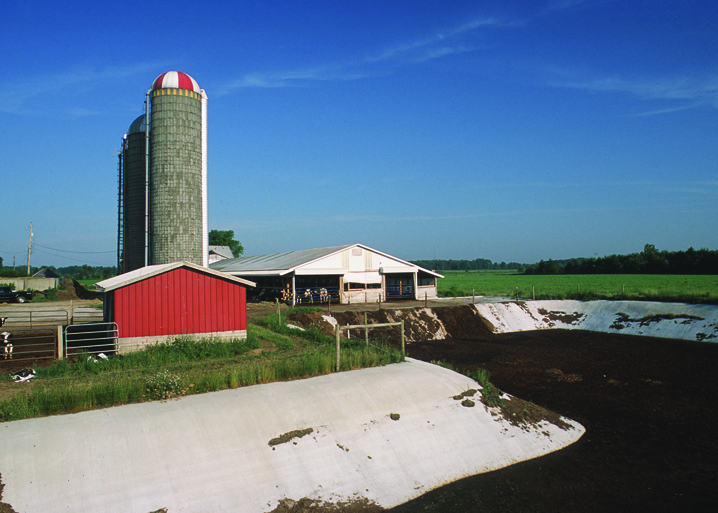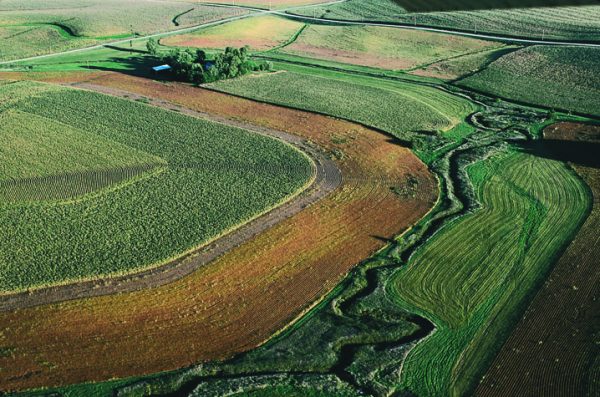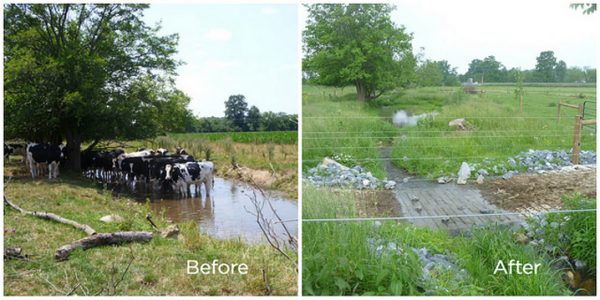NWQI Targets Conservation Efforts in Small Watersheds

Concrete-lined manure storage pond with cattle barn and push-off slope. Newaygo County, Michigan. (Photo Credit: Fred Gasper, USDA Natural Resources Conservation Service, via Wikimedia Commons, https://commons.wikimedia.org/wiki/File:NRCSMI01062_-_Michigan_(4713)(NRCS_Photo_Gallery).jpg.)
We all rely upon a steady supply of clean water. In some communities, that water supply is more closely tied to agriculture than others. For agricultural communities with small watersheds, every decision made by each user has a major impact on water wells, the surrounding landscape, and on nutrient levels in waterways even far away.
Today, many local farmers are working to implement conservation practices to improve and protect water quality. The USDA’s Natural Resources Conservation Service (NRCS) is working to help them do that through the National Water Quality Initiative (NWQI).
Collaborating in communities
Issues that negatively affect water quality can also make farming more difficult day-to-day. For example, without a manure pit for storage, small farmers often must haul manure every day. Some farmers are forced to spread manure over fields to avoid it building up.
Herds frequently use surface water that runs on farmland, but when it’s not protected, it can become contaminated—and that’s dangerous for both people and livestock. Conservation practices such as nutrient management plans, streambank fencing with animal crossings, streambank buffer zones, and manure storage tanks can remedy these issues, but implementing them can be expensive.
Laura Crowell, Acting Communications Coordinator (Disaster Recovery/Partnerships) of the NRCS Public Affairs Division, explained what inspired the NRCS program and described its basic aims to EM.
“Clean water is essential for healthy communities and ecosystems, and protecting and improving it through voluntary conservation assistance to farmers, ranchers, and foresters is part of the mission of NRCS,” explains Crowell. “There are many high-profile water quality issues like those in the Gulf of Mexico and Chesapeake Bay that draw national attention. Impairments of smaller water bodies, streams and lakes, across the country often have a more immediate impact on communities than those higher-profile issues.”
Fortunately, there’s an easier way to clean up local water bodies. It can be accomplished more readily by supporting targeted efforts in small watersheds. Enter 2012’s National Water Quality Initiative (NWQI).
“NWQI began in 2012 as a collaborative water quality effort between NRCS, the U.S. Environmental Protection Agency (EPA), and the state water quality agencies to reduce agricultural nonpoint sources of nutrient, sediment, and pathogen pollution in small agricultural watersheds,” details Crowell. “The long-term goal of the NWQI is to achieve water quality improvements through accelerated conservation practice implementation using a targeted approach, based on robust watershed-scale plans.”
NWQI has had a lot of success achieving buy-in from local farmers. In fact, according to Crowell, producer engagement and participation is essential for meeting water quality goals.
“NWQI supports the voluntary conservation model by relying on and enhancing some of the core strengths of NRCS service delivery model,” Crowell describes. “We work closely with local partners and producers to understand conservation priorities in an area. NRCS is trusted as a source of technically credible conservation solutions for farmers, solutions that are designed with their interests and commercial operations in mind. So, with NWQI, we are supporting win-win solutions for the farmers and for clean water.”

Grass filter strip along a stream on the Elmer Grote farm in Carroll County, Iowa. (Photo Credit: Lynn Betts / Photo courtesy of USDA Natural Resources Conservation Service)
NWQI helps support working relationships and strengthens local partnerships that help provide targeted outreach and technical assistance to producers.
“For example, technical assistance funding provided through NWQI has been used to support producer workshops, local watershed coordinators, watershed planning efforts, and one-on-one outreach and planning with landowners in some watersheds,” states Crowell.
NWQI participants receive technical assistance from NRCS on implementing a wide range of conservation systems that address pollutant(s) of concern. Crowell explains that this includes assistance with structural, vegetative, and management practices.
Structural assistance might include engineering designs for waste storage facilities, grade stabilization structures, or water and sediment control structures. Assistance with vegetative practices might include seed mixes, methods for planting cover crops or installing filter strips. And NWQI management practices might include grazing management plans, no-till planting, or irrigation water management.
Lasting benefits
Based on the numbers, the NWQI is working.
“NRCS has provided almost $220 million in NQWI financial and technical assistance in more than 275 watersheds since 2012,” Crowell describes. “Through NQWI we’ve worked with more than 3,500 producers to adopt conservation practices on 725,000 acres in priority watersheds. To date, at least nine impaired water bodies have been improved and subsequently scheduled for de-listing, or otherwise removed from NWQI due to successful water quality improvements.”
What is the secret to the program’s success? A close connection between local needs and provided services.
“A key factor to NWQI success is that it helps provide effective dedicated support for targeted local efforts,” remarks Crowell. “So, where there has been success, it is because the program has been aligned with the conservation needs identified and supported by local farmers as well as other stakeholders.”
Another reason NWQI is successful is the NRCS and local teams’ choice of small, local watersheds for the program.
“NRCS and state partners select priority watersheds where NWQI can be most effective and where watershed planning is already underway,” clarifies Crowell. “NWQI supports and energizes local watershed efforts by providing additional assistance with assessment and outreach, as well as financial assistance, to help local partners implement their watershed action plans.”
There are real benefits for participants in this program, beyond cleaner water. Participant farmers can benefit from working with NWQI in multiple ways.
“NRCS works directly with producers to help achieve their operational objectives—whether that is improved efficiency, reduced labor, flexibility, or improving the bottom line, in addition to addressing resource concerns,” adds Crowell.

(Before) Cows had full access to a stream that winds throughout the Weaver farm in the Saucony Creek Watershed. (Photo Credit: Nick Ramsey, NRCS) (After) Streambank fencing and a stream crossing restrict cattle access to stream. (Photo Credit: Molly Hippensteel, NRCS)
In other words, to see more successful conservation, NRCS knows they need to look at successful local farming operations, from stem to stern.
“NWQI supports conservation on working lands,” details Crowell. “And for farmers to maintain those conservation systems, and the water quality benefits they generate, our customers must also maintain the economic health of their farming operation. The need for water quality improvements and economic stability must be balanced. Through NWQI there are many opportunities that offer a win-win solution for the farmer and for the environment.”
Farmers who participate in NWQI inspire others to take part and show a greater sense of stewardship toward the land and water—stewardship that is part of a long-established farming tradition.
“Studies have shown that ‘early adopters,’ innovative farmers who implement and experiment with conservation practices, help neighbors learn about new practices through first-hand observation,” remarks Crowell. “Strong conservation leaders in the watershed can inspire others, and farmer-to-farmer contact stimulates sharing and education of conservation benefits. The National Wildlife Federation, for example, highlighted the key role of ‘cover crop champions’ who are willing to share their experiences with others. The study found that the very presence of early adopters increased other farmers’ access to infrastructure, equipment, and knowledge.”
This momentum, along with the local farming tradition, helps move farmers to become participants. The program then works to motivate participants to keep up their efforts.
“NWQI fosters strong local partnerships that support ongoing water quality efforts and keep producers motivated,” Crowell describes. “A producer will continue using a practice if it fits well with their operation and they can easily see the benefits to their operation and local natural resources. NWQI supports monitoring and other tools for demonstrating conservation benefits to share with landowners in the watershed.”
In other words, NWQI is a long-term investment; farmers will learn more sustainable practices,
teach them to others, and hopefully, pass them on to the next generation.
“NWQI provides the opportunity to accelerate efforts within a watershed with the goal of building a strong community-led effort that will keep the momentum needed to achieve long-term water quality goals,” states Crowell. “This gets back to the win-win proposition for the farmer and for water. The goal of NRCS financial assistance programs is that our customers will incorporate long-term conservation into their operations that is also economically sustainable.”
This isn’t to say that the NRCS sees its work as finished—far from it.
“The work of conservation is continuous,” adds Crowell. “Farmers, now and in the future, will
constantly need to adjust their operations based on the markets, technology changes, environmental conditions—among many other factors. So, while NWQI investments should pay dividends well into the future, conservation is something that must be a continuous investment.”
Top image: Concrete-lined manure storage pond with cattle barn and push-off slope. Newaygo County, Michigan. (Credit: Fred Gasper, USDA Natural Resources Conservation Service, via Wikimedia Commons, https://commons.wikimedia.org/wiki/File:NRCSMI01062_-_Michigan_(4713)(NRCS_Photo_Gallery).jpg.




0 comments